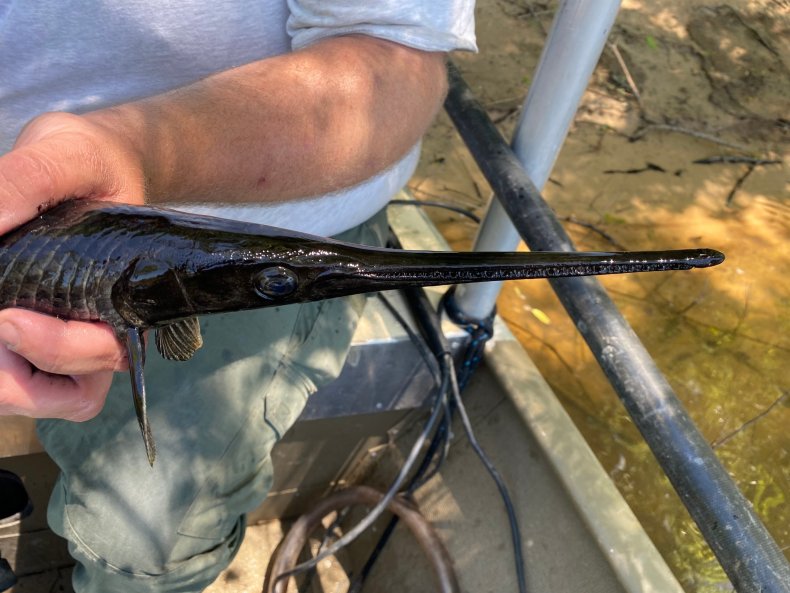BY ROBYN WHITE ON 6/24/22
A prehistoric jet black river creature with shark-like teeth has been caught in the Choctawhatchee River in Florida.
The melanistic longnose gar was found by the Fish and Wildlife Research Institute while biologists were on a routine long-term monitoring trip.
Photographs posted by the institute show the bizarre creature being held up to the camera. It appears to have black eyes and a long row of black teeth.
"What's black as tar, has armored scales and a mouth full of teeth? A melanistic longnose gar!" the institute said on Facebook." Melanism is an abnormal extent of dark coloration in the skin, scales, fur, or feathers of animals and is characterized by excessive deposits of melanin. It's relatively rare in animals and is not seen often by biologists."

The gar that was caught in Florida. It is completely black, with a long row of teeth.
FWC FISH AND WILDLIFE RESEARCH INSTITUTE
In comments to the Facebook post, the Institute said the gar was released back into the water after it was caught.
The longnose gar has swum through North American waters for over 100 million years. They are usually olive brown in color, making this one a rare exception.
Gars are known for being large fish. Longnose gar usually reach about 3 feet, however some species such as the alligator gar, can grow up to 8 feet long. They usually live in slow moving water, such as estuaries.
Often, the species are mistaken for logs, as they like to bask on the surface of the water. They usually feed on smaller fish.
Although rare, melanistic animals are occasionally spotted by fishermen.
In May, Texas anglers Justin Jordan and Terrell Maguire were out fishing on a marsh in southeast Texas when they came across a "very rare" melanistic alligator gar.
Jordan estimated it was about 5 feet long—however the species can reach enormous lengths.
Alligator gars are the biggest of the gar fish species. The fish only live in North and Central America and are known for their size.
Two gar species are found in Florida, including the longnose gar and the Florida gar. They are sometimes mistaken for smaller alligator gars, which are not as abundant in the state.
It's legal to catch and harvest gars, however it's strictly prohibited to catch the alligator gar, as it's an endangered species. Any that are caught have to be released back into the water, unless a permit is obtained.
Not much is known about melanistic gars, and how many live in North America's waters, as they are so rarely seen.
It's unclear how big the gar caught by the Institute was, however the biggest longnose ever caught in the state weighed 41 pounds.
In comments to the Facebook post, the Institute said the gar was released back into the water after it was caught.
The longnose gar has swum through North American waters for over 100 million years. They are usually olive brown in color, making this one a rare exception.
Gars are known for being large fish. Longnose gar usually reach about 3 feet, however some species such as the alligator gar, can grow up to 8 feet long. They usually live in slow moving water, such as estuaries.
Often, the species are mistaken for logs, as they like to bask on the surface of the water. They usually feed on smaller fish.
Although rare, melanistic animals are occasionally spotted by fishermen.
In May, Texas anglers Justin Jordan and Terrell Maguire were out fishing on a marsh in southeast Texas when they came across a "very rare" melanistic alligator gar.
Jordan estimated it was about 5 feet long—however the species can reach enormous lengths.
Alligator gars are the biggest of the gar fish species. The fish only live in North and Central America and are known for their size.
Two gar species are found in Florida, including the longnose gar and the Florida gar. They are sometimes mistaken for smaller alligator gars, which are not as abundant in the state.
It's legal to catch and harvest gars, however it's strictly prohibited to catch the alligator gar, as it's an endangered species. Any that are caught have to be released back into the water, unless a permit is obtained.
Not much is known about melanistic gars, and how many live in North America's waters, as they are so rarely seen.
It's unclear how big the gar caught by the Institute was, however the biggest longnose ever caught in the state weighed 41 pounds.

A picture shows the gar being held by a biologist. The creature was a rare find.
FWC FISH AND WILDLIFE RESEARCH INSTITUTE
No comments:
Post a Comment